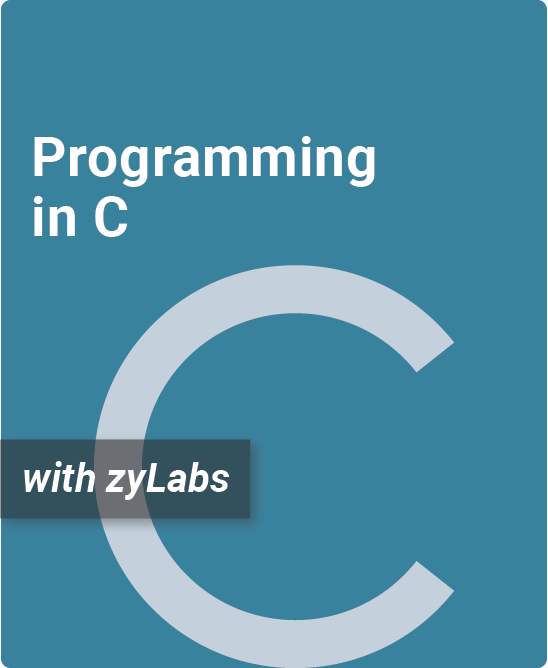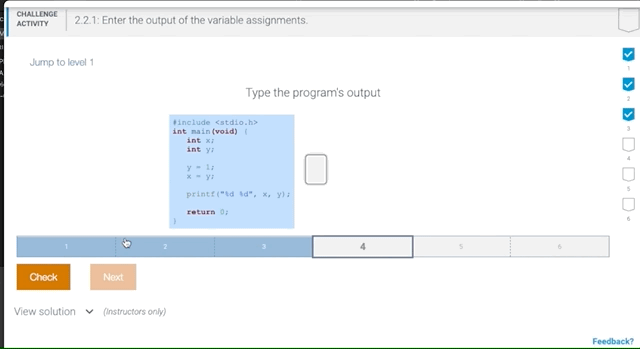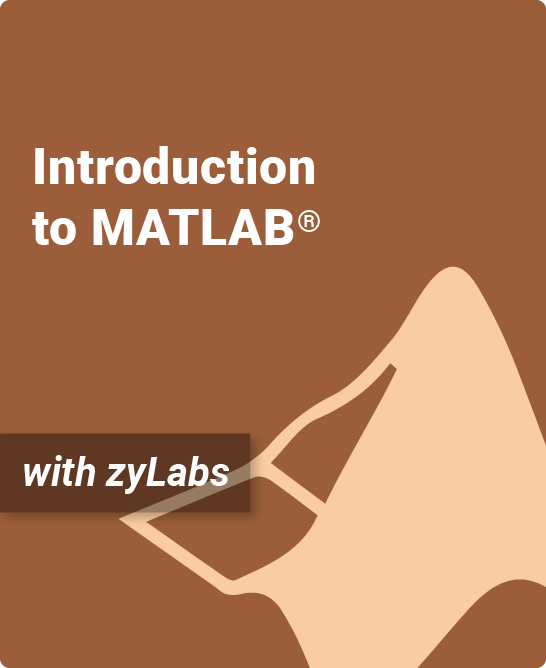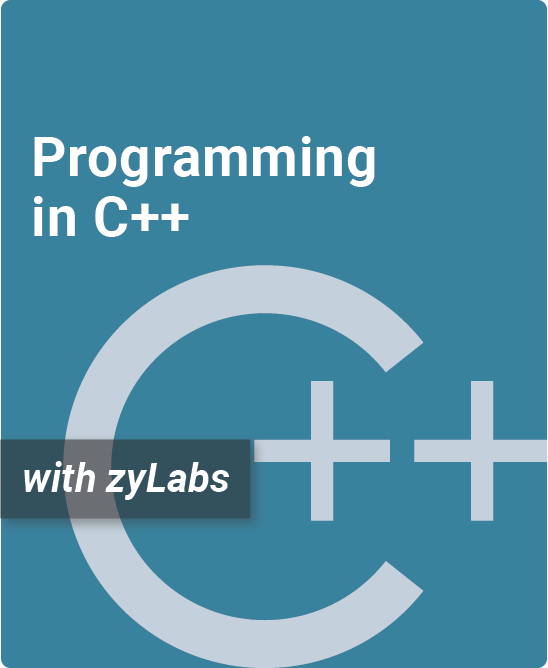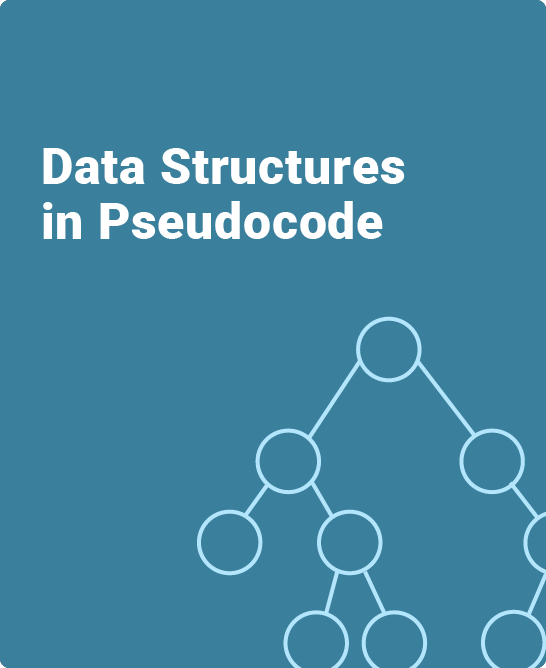Table of Contents
1. Introduction to C
1.1 Programming (general)
1.2 Programming basics
1.3 Comments and whitespace
1.4 Errors and warnings
1.5 Computers and programs (general)
1.6 Integrated development environment
1.7 Computer tour
1.8 Language history
1.9 Problem solving
1.10 Why programming
1.11 Why whitespace and precision matter
1.12 C example: Salary calculation
1.13 C example: Married-couple names
2. Variables / Assignments
2.1 Variables and assignments (general)
2.2 Variables (int)
2.3 Identifiers
2.4 Arithmetic expressions (general)
2.5 Arithmetic expressions (int)
2.6 Example: Health data
2.7 Floating-point numbers (double)
2.8 Scientific notation for floating-point literals
2.9 Constant variables
2.10 Using math functions
2.11 Integer division and modulo
2.12 Type conversions
2.13 Binary
2.14 Characters
2.15 Strings
2.16 Integer overflow
2.17 Numeric data types
2.18 Unsigned
2.19 Random numbers
2.20 The printf and scanf functions
2.21 Debugging
2.22 Style guidelines
2.23 C example: Salary calculation with variables
2.24 C example: Married-couple names with variables
3. Branches
3.1 If-else branches (general)
3.2 Detecting equal values with branches
3.3 Detecting ranges with branches (general)
3.4 Detecting ranges with branches
3.5 Detecting ranges using logical operators
3.6 Detecting ranges with gaps
3.7 Detecting multiple features with branches
3.8 Common branching errors
3.9 Example: Toll calculation
3.10 Oder of evaluation
3.11 Switch statements
3.12 Boolean data type
3.13 String comparisons
3.14 String access operations
3.15 Character operations
3.16 Conditional expressions
3.17 Floating-point comparison
3.18 Short circuit evaluation
3.19 C example: Salary calculation with branches
3.20 C example: Search for name using branches
4. Loops
4.1 Loops (general)
4.2 While loops
4.3 More while examples
4.4 For loops
4.5 More for loop examples
4.6 Loops and strings
4.7 Nested loops
4.8 Developing programs incrementally
4.9 Break and continue
4.10 Variable name scope
4.11 Enumerations
4.12 C example: Salary calculation with loops
4.13 C example: Domain name validation with loops
5. Arrays / Vectors
5.1 Array/vector concept (general)
5.2 Vectors
5.3 Array iteration drill
5.4 Iterating through vectors
5.5 Multiple arrays
5.6 Swapping two variables (general)
5.7 Loop-modifying or copying/comparing arrays
5.8 Debugging example: Reversing an array
5.9 Two-dimensional arrays
5.10 Char arrays / C strings
5.11 String library functions
5.12 Char library functions: ctype
5.13 Arrays and strings
5.14 C example: Annual salary tax rate calculation with arrays
5.15 C example: Domain name validation with arrays
6. User-Defined Functions
6.1 User-defined function basics
6.2 Print functions
6.3 Reasons for defining functions
6.4 Writing mathematical functions
6.5 Functions with branches
6.6 Functions with loops
6.7 Unit testing (functions)
6.8 How functions work
6.9 Functions: Common errors
6.10 Pass by pointer
6.11 Functions with array parameters
6.12 Functions with C string parameters
6.13 Functions with array parameters: Common errors
6.14 Scope of variable/function definitions
6.15 Parameter error checking
6.16 Preprocessor and include
6.17 Separate files
6.18 C example: Salary calculation with functions
6.19 C example: Domain name validation with functions
7. Structs
7.1 Grouping data: struct
7.2 Structs and functions
7.3 Structs and arrays
7.4 Structs, arrays, and functions: A seat reservation example
7.5 Separate files for structs
8. Pointers
8.1 Why pointers: Pass by pointer example
8.2 Pointer basics
8.3 The malloc and free functions
8.4 Pointers with structs
8.5 String functions with pointers
8.6 The malloc function for arrays and strings
8.7 The realloc function
8.8 Vector ADT
8.9 Why pointers: A list example
8.10 A first linked list
8.11 Memory regions: Heap/Stack
8.12 Memory leaks
8.13 C example: Employee list using vector ADT
9. Input / Output
9.1 The stdout and stdin file pointers
9.2 Output formatting
9.3 Input parsing
9.4 File input and output
10. Recursion
10.1 Recursion: Introduction
10.2 Recursive functions
10.3 Recursive algorithm: Search
10.4 Adding output statements for debugging
10.5 Creating a recursive function
10.6 Recursive math functions
10.7 Recursive exploration of all possibilities
10.8 Stack overflow
10.9 C example: Recursively output permutations
11. Searching and Sorting Algorithms
11.1 Searching and algorithms
11.2 Binary search
11.3 O notation
11.4 Algorithm analysis
11.5 Sorting: Introduction
11.6 Selection sort
11.7 Insertion sort
11.8 Quicksort
11.9 Merge sort
12. Artificial Intelligence
12.1 Artificial intelligence
12.2 Generative AI and LLMs
12.3 Generative AI in action
12.4 Building AI systems
12.5 Risks and ethics in AI
13. Additional Material
13.1 Do-while loops
13.2 Engineering examples
13.3 Command-line arguments
13.4 The #define directive
13.5 Compiling and running a program using a command-line interface
13.6 Modular compilation
13.7 Makefiles
13.8 Binary file I/O
13.9 Engineering examples using functions
13.10 Command-line arguments and files
13.11 Additional practice: Output art
13.12 Additional practice: Grade calculation
13.13 Additional practice: Abbreviation decoder
13.14 Additional practice: Dice statistics
13.15 zyBooks built-in programming window
Collaborative Coding Made Simple: A Guide to Group and Paired Programming with zyBooks
Teach C with this hands-on, interactive zyBook with zyLabs
Programming in C is a comprehensive introduction to the foundational principles and practice of C programming, based on the latest standards.
- Covers foundational constructs, like branches, loops, and functions, and advanced topics, like inheritance, exceptions, and plotting
- Packed with over 600 interactive coding exercises and learning activities to help students master the material
- Customizable so instructors can reorganize, edit, and add their own learning content
- Adopters have access to a test bank with over 400 questions
- New AI Chapter includes essential Artificial Intelligence concepts and an overview of current AI applications
What is a zyBook?
Programming in C is a web-native, interactive zyBook that helps students visualize concepts to learn faster and more effectively than with a traditional textbook. Check out our research.
Since 2012, over 1,800 academic institutions have adopted digital zyBooks to transform their STEM education.
zyBooks benefits both students and instructors:
- Instructor benefits
- Customize your course by reorganizing existing content, or adding your own content
- Continuous publication model updates your course with the latest content and technologies
- Robust reporting gives you insight into students’ progress, reading and participation
- Save time with auto-graded labs and challenge activities that seamlessly integrate with your LMS gradebook
- Build quizzes and exams with hundreds of included test questions
- Student benefits
- Learning questions and other content serve as an interactive form of reading
- Instant feedback on labs and homework
- Concepts come to life through extensive animations embedded into the interactive content
- Review learning content before exams with different questions and challenge activities
- Save chapters as PDFs to reference the material at any time
What is a zyLab?
See the capabilities of the zyBooks programming environment
Authors
Frank Vahid
Computer Science PhD, Univ. of California, Irvine / zyBooks Co-Founder
Roman Lysecky
Professor Emeritus of Electrical and Computer Engineering, Univ. of Arizona
